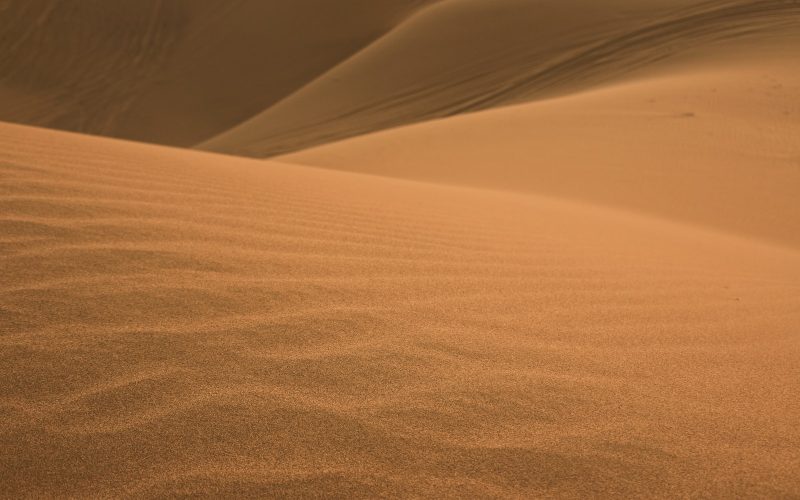Sand is a naturally occurring material made of tiny particles of weathered rocks, shells, and organic materials.
It is found worldwide and is often used in construction, landscaping, and other projects. But did you know that there are actually several different types of sand?
In this blog post, we’ll explore the various types of sand and where to find them. From white to black, pink to green, each type of sand offers unique benefits and can be used in various applications.
So let’s dive in and learn more about the different types of sand!
1. Immature Sand
Immature sand is a type of sand that is not yet fully developed. It comprises small particles of rock and minerals that are still eroded and processed by natural forces. This sand can be found on beaches and coastal areas near rivers or streams.
Immature and has the potential to contain a high amount of moisture, making it easier to mold and shape when compared to other different types of sand.
This makes it popular for use in landscaping and construction projects, as it allows more accurate shapes of structures and objects.
Additionally, immature sand may be used for decorative purposes as its unique color and texture can add a unique aesthetic appeal to an area.
2. Pit Sand
Pit sand is a coarse sand mainly made up of quartz. It is usually light brown in color and can vary in shades ranging from yellow to orange.
This type of sand is extracted from deep pits and is usually used for concrete and mortar purposes.
Pit sand is one of the coarser varieties of sand with angular particles and is widely used in construction due to its durability and strength.
It is also widely used in filtration systems and can be used as a bedding material for road paving. This is second on our list of the different types of sand you should know.
3. Sea Sand
Sea sand is a very versatile type of sand and can be used in various ways. It is commonly used in beachfront, dune systems, other coastal areas, and the construction industry.
Sea sand is made up of rock fragments, shells, pebbles, and other materials, and it can range in color from light brown to yellowish.
This type of sand is also great for use in landscaping projects, as it can help with drainage and erosion control.
Its small particles can absorb more water than larger-grained sand and resist wind and water erosion.
Sea sand also helps increase soil fertility as it contains high levels of minerals and nutrients.
4. Green Sand
The fourth on this list of the different types of sand is Green sand, composed mainly of tiny bits of green mica or glauconite. It is most often found in shallow ocean waters and along coastal regions.
This sand is great for making glass and pottery, as the tiny green particles give the objects a unique texture and color.
The sand is also used as an abrasive material for cleaning and polishing various surfaces. Green sand is also used as an agricultural soil conditioner and helps to add minerals to the soil. It does this while providing a porous structure that increases water retention.
5. Desert Sand
Desert sand is a unique type of sand found in desert areas. It is usually composed of tiny grains of quartz and other mineral materials that the elements over thousands of years have worn down.
Desert sand is typically light-colored and varies in color from yellow to orange to red, depending on the mineral content.
Additionally, it is very fine and does not retain water well, making it difficult to use for construction projects.
Desert sand can be used for decorative purposes or as an abrasive material in certain industrial applications. It is one of the different types of sand one should be aware of.
6. Lithic Sand
Lithic sand is angular sand that is made up of naturally occurring rock particles. This type of sand is usually gray or white in color and has a slightly gritty texture.
It is often used as a filler material in construction projects and for traction in roadways and walkways.
Lithic sand is one of the several different types of sand and can also be used in landscaping to create a more natural look.
In addition, lithic sand can be used in gardening and potting soils to improve drainage and aeration.
7. Mixed Carbonite-Silicate Sand
Mixed Carbonite-silicate sand is a type of sand that is composed of both carbonate and silicate materials. It is usually a mix of quartz, feldspar, mica, and trace elements.
This type of sand can be found in many locations worldwide, including beaches, deserts, rivers, and even mountain ranges.
Its combination of minerals makes it an excellent choice for construction projects such as foundations, pathways, patios, and driveways.
In addition, it also has excellent drainage properties, making it a great choice for areas that may experience significant rainfall or snowfall.
As with the other different types of sand, it must be handled carefully to prevent it from contaminating other materials.
8. Biogenic Sand
Biogenic sand is the type of sand that comes from organic material, such as shells, corals, and other marine life.
This sand is composed of calcium carbonate, which is naturally occurring and is the main component of most marine organisms.
It is a white-to-tan color with a light texture that can be found along beaches and shores.
Biogenic sand can be used for various things, including making concrete, filtration systems, and even decoration.
It is also important for providing nutrients to beach ecosystems, helping plants grow, and providing habitat for small animals.
9. Garnet Sand
Garnet sand is one of the many different types of sand available in the market and an important type of sand that is often used in abrasive blasting and water filtration.
This sand is produced from naturally occurring garnet rocks that are crushed into fine particles. These are then needed to be sorted into different grades based on the size of the particles.
This sand is known for its hardness and durability, which makes it great for industrial purposes. Additionally, it’s also available in different colors, so it can be used for decorative purposes as well.
10. Olivine Sand
Olivine sand is an igneous rock consisting of crystal grains of green to yellow-green minerals. Olivine sand has many uses in the industry due to its unique properties. It is commonly used as a component in abrasives, foundry sand, and cement.
This type of sand is also used in landscaping, water filtration systems, and certain types of oil refining.
As a naturally occurring mineral, Olivine sand can be found in beach sand deposits and some river beds.
11. Volcanic Sand
Volcanic sand is the product of eroded volcanic rocks. It is typically composed of small particles that are dark in color due to its iron content.
Volcanic sand is a good choice for projects requiring large amounts of sand, as it is available in large quantities and can be found in many places worldwide.
Because it is so abundant, it tends to be cheaper than the other different types of sand. It is also heavier than other types of sand, making it ideal for projects that require stability.
Volcanic sand can also be used in gardening and landscaping, as it can help with drainage and soil aeration.
12. Heavy Mineral Sand
Heavy mineral sand is a type of sand that contains minerals such as rutile, zircon, ilmenite, and magnetite. It is usually found in beach and dune settings and other sand particles.
Heavy mineral sand has many uses, from manufacturing specialty glass to water filtration systems.
This type of sand is also used to produce abrasives and oil and gas recovery products. The minerals contained within this type of sand have a variety of colors, from black to white.
The colors depend on the mineral composition, which can vary greatly from one area to another.
13. River Sand
River sand is one of the most common and different types of sand used in construction and landscaping projects. The continual erosion of sediment along shorelines and stream beds creates it.
This type of sand is primarily composed of quartz, feldspar, and other minerals, making it very durable and resistant to weathering.
River sand is especially popular among homeowners as it provides a natural look to landscapes. In addition to that, it can be easily obtained from riverbanks and other areas near rivers.
It is also typically cheaper than the other different types of sand, making it a cost-effective option for many projects.
14. Silica Sand
Silica sand is made of quartz and is one of the most abundant and commonly found different types of sand on Earth.
This type of sand is usually found in beach sand, riverbeds, and deserts. Furthermore, it can be used for various purposes, including water filtration, glassmaking, and sandblasting.
Because it is so widespread, silica sand is easy to obtain and can be used for various applications.
Silica sand is also very strong, durable, and resistant to heat, making it a great option for landscaping, masonry, and other construction projects.
15. Gypsum Sand
Gypsum sand is a type of sand that has been formed from the mineral gypsum. It is one of the different types of sand that is usually found in desert climates and is usually white or light tan in color.
Gypsum sand is extremely soft due to its nature of being created from a single mineral. This type of sand is also less common than other types of sand, making it more difficult to find in certain locations.
Gypsum sand is commonly used in construction projects and other building materials, as it is lightweight and easy to work with.
16. Glass Sand
Glass sand is a type of sand that is composed mainly of finely ground glass particles. It is commonly used in the construction industry and can also be used in landscaping projects.
It can serve as an ingredient in concrete mixes and a decorative element in gardens and swimming pools.
Glass sand is usually sourced from recycled glass bottles and jars. However, some sources may be more environmentally friendly than others.
Glass sand is also often used for filtration systems because it captures and retains small particles, such as bacteria and viruses. This winds up our list of the different types of sand in the market.
Conclusion
Sand is an essential part of the environment, and it can be found all around the world. Different types of sand are used for various purposes, from construction to recreational activities.
This blog post explored the different types of sand, their uses, and where you can find them.
From white sand beaches to black sand deserts, each type of sand has its own unique characteristics that make it special.
Read the guide above to learn more about the different types of sand and where you can find them.








